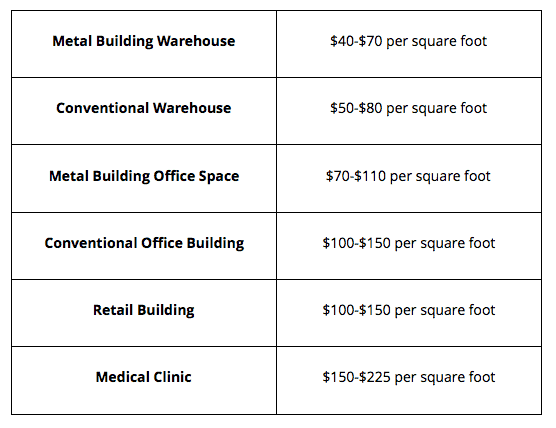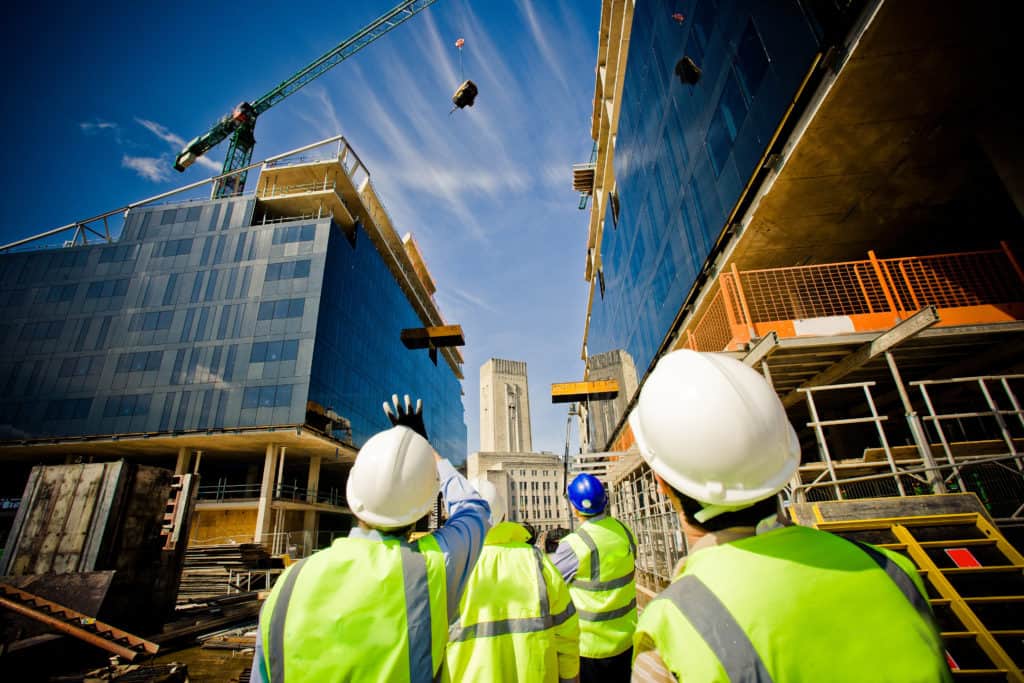In recent studies, statistics show that not all types of construction cost the same per square foot – and even more importantly, the price of construction per square foot varies a great deal depending upon location across the United States. In fact, location alone can represent as much as 70% of the cost driver for a single-story office building, with the median for this type of construction ranging between $160 and $170 per square foot. Keeping these figures in mind, it’s no surprise that New York tops the charts for the most expensive city to build in for all of these building types.
Because the age-old question “How much does office building construction cost?” is not one that can be easily answered, it remains a topic of debate for many to this day. Due to the wide variation in costs across different markets, there is no simple one-size-fits-all answer.
For example, new structures in shell condition will be much more expensive than second-generation buildings, whereas items such as doors, certain material finishes, ceilings, etc. can be repurposed for a build-out. In this article, we’ll explore cost-influencing factors that can affect the prices of commercial building construction across the U.S.
Table of Contents
How Much Does a Construction Project Cost?
As we’ve touched upon, the cost of commercial construction projects fluctuates a great deal depending on a variety of factors, including many pertinent variables such as:
- Location/region
- Type of structure/design
- Size of building
- To what building code
- For what purpose
- Standards and features
- Quality/grade of materials used
- General labor costs
- The experience of the contractor and his costs
- Industry type (i.e., is the building in question a small corporate office in a residential setting, or a massive headquarters-type structure in a major city)
Below is a chart with rough estimates of the cost of various commercial construction projects in the Midwest. However, it is important to note that this information isn’t attempting to account for the many factors that can cause such fluctuation, but to simply provide a general reference point with regard to the cost of different types of commercial buildings:

As rates vary by region, you must specify this information before determining the costs of anything. In order to get a true determination of the cost of build-out, you need to specify not only the square footage, but the height of the building, as well as the materials used in construction. Many experts use reference guides such as Spon’s Architect’s and Builder’s Price Book (by year) for typical construction costs.
What Affects Building Cost
Some factors that affect the costs of building any commercial project are; building materials, location, building type, labor, and finishing.
Building materials
The material used to construct a building will influence the total cost of the construction project. The more expensive the building material is, the more expensive the construction will be.
For example, building with prefabricated material like wood will be cheaper than building with highly fabricated material like steel.
Location
The place you choose to build will determine the final costs you incur. Generally, building in a highly populated urban area like New York City will be more costly than building in a less populated area in the Midwest.
Building type
The building influences the cost per square foot as different buildings are used for different needs. For example, a high-rise office building will cost more than a low-rise single-story warehouse.
Labor
Labor costs are hard costs that take up from 20% to 40% of building costs. Labor costs can be calculated by determining employee wages, training, and benefits.
Finishes
The finishes used in a building will affect its costs. High-grade finishes cost more compared to mid or low-grade finishes.
How Geography & Zoning Affect Construction Costs
In addition to the type of building in question, there are several other key geographical factors to take into consideration when determining commercial construction costs. One of the most important factors is zoning – depending on what the land is zoned for will determine the cost of each of the various permits you’ll need in order to begin construction. Zoning will also determine, at least in part, what type of materials will be required for the build.
More specifically, the geographical location and its topography also play a significant role in construction costs. For example, in earthquake-prone zones such as California, seismic zoning will directly affect the cost of materials, supplies, and labor, since the code requirements for concrete, for example, are much more stringent than other areas across the United States.
Other geographical factors to be considered are hillside ordinances (if applicable) and proximity to the ocean (if applicable); these two variables are also a part of the geotechnical factor.
Furthermore, soil types are a big part of what site prep work may need to be done in order for building to commence – for example, building a foundation on land that has a high acidity (pH level) versus building in an area where the soil is clay-rich (or in a very sandy or damp area) will directly impact the type of materials used, and consequently affect cost of labor, level of contractor expertise entailed, and so on.
Keeping all of this information in mind, you can see why it is nearly impossible to obtain a ballpark quote when it comes to construction costs without specifying the site location and the ensuing the variables of that particular region.

How costs differ in the different regions in the USA
Below is a breakdown of the average costs for a commercial project per square foot in the East, West, Midwest, and South United States.
Eastern US.
We acquired the average construction costs per square foot by analyzing costs in New York, Washington, Boston, Philadelphia, and Raleigh Durham.
On the higher side, the estimated construction costs of a single-story commercial building are $361 per square foot and $301 on the lower side.
In constructing a mid-rise office building, costs range between $719 on the high and $599 on the low. High-rise buildings have the highest average cost ranging between $688-$827 per square foot.
Shopping malls in the Eastern US are expensive, with $461 as the least amount to purchase and $554 as the highest. The neighborhood strip center's construction cost estimate is $371 and $309 per square foot.
A three-star hotel can cost $489 on the lower side and $604 on the higher side, while a five-star hotel shoots up to $677 on the lower end and $871 on the higher end.
To construct a school, you will need an average cost of $317 to $381
Western US.
The cities that calculate the average costs in the Western US are Las Vegas, Seattle, Honolulu, Portland, Sacramento, and San Diego.
The average cost to construct a single-story commercial building is $313 on the low and $378 on the high. For mid-rise buildings, the average price range is between $481- $607. High-rise buildings' cost estimate is $557 on the low and $730 on the high.
Shopping malls in the Western US are between $442 as the least amount to purchase and $575 the highest. The neighborhood strip center's construction cost estimate is $261 and $413 per square foot.
The three-star hotels have low average costs of $402 and an average high of $545. The prices of five-star hotels are a bit higher, with costs ranging between lows and highs of $577 and $849.
To build a school, the cost ranges between $341 and $417. Construction costs of schools in Honolulu are significantly higher by $10 per square foot.
US Midwest
The average costs were obtained from the costs of Denver, Nashville, and Chicago in the Midwest.
Single-story commercial building costs average from as low as $298 to as high as $237 per square foot. In a mid-rise building, the cost average is $454 on lows and $556 on highs. High-rise buildings are slightly expensive, costing $554 on the low and $689 on the high.
The neighborhood strip center construction cost estimate is cheaper, with costs ranging between $284 and $340.
When building a hotel, the costs of a three-star hotel average between $400 and $533 while that of a five-star hotel stands between $537 on the low and $762 on the high.
For school buildings, the average cost is $290 and $242 per square foot.
Southern U.S.
The estimated costs in the Southern U.S. are obtained from cities like; Dallas, Orlando, Atlanta, and Miami.
Constructing a single-story commercial building in the Southern US will cost you an average of $238 and $286 per square foot. A mid-rise building costs between $474 on the lower and $569 on the higher sides. A high-rise commercial building price is between $545 on the lows and $654 on the highs per square foot.
In the Southern US, shopping malls range between $462 and $683.
The neighborhood strip malls cost between $245 on the lower end and $294 on the higher end.
A three-star hotel ranges between $371 and $478, while a five-star hotel costs between $62 and $683.
School buildings in the Southern U.S. cost between $217 and $260.
What Does An Office Build Out Mean?
In addition to determining the cost of new commercial office buildings, there is also the instance of office build-out. For those unfamiliar with the general terminology, a build out is defined by Wikipedia as an urban planner’s estimate of the amount and location of potential development for an area. Sometimes called a “lot-yield analysis,” build-out is one step of the land use planning process. Evaluation of potential development impacts, therefore, begins with a build-out analysis.
In the instance of leasing commercial office spaces, occupants or tenants won’t find exactly what they want as far as furnishings, fixtures, or even the floorplan of the space in question. As a result, the majority of commercial office building spaces will require some degree of office build out (also known as “tenant finish out”), whether it entails new carpeting and fresh paint, a demo of the existing walls (or building new walls), adding a sink with cabinets, and so on.
Oftentimes companies get overwhelmed with the notion of building out space or the cost involved, and never understand that it’s a negotiable item that the landlord will potentially pay for. Below, a few general guidelines to follow regarding office space build-outs, what a buildout means, average costs, and who pays.
Office Build Out
Simply put, an office build-out is when a landlord’s contractor (or your contractor) perform construction on an office space to install walls, carpeting, paint, sinks, HVAC, ceilings, lighting, plumbing, bathrooms, and other such features, fixtures, and/or material finishes. The process of building out office space is also known as a tenant finish or commercial tenant improvements. Who pays for an office build-out depends on how you negotiate your lease contract. In some instances, the landlord will pay for 100% of a standard build-out; however, if you want high-end finishes, you may end up coming up a bit out of pocket.
The management of this process also depends on the size and scope of work. For most small jobs, the landlord’s property manager will manage the construction; however, in other cases (such as larger office leases), the tenant may choose to have their own project manager on the job. There are typically a couple of ways to go about negotiating this: you can either negotiate to have the landlord turnkey the build-out, or give a tenant an improvement allowance.
Turnkey Office Build Out
This refers to a build-out where the landlord builds out the space per the tenants’ specifications (and at the landlord’s sole cost). In other words, the property is upgraded and upon completion, move-in ready – all the tenant has to do is literally turn the key. During the lease negotiations, the tenant and landlord engage the landlord’s architect to design a mutually agreeable plan.
The allowances will all be building standard, and the tenant chooses the carpet and paint colors. The downside of a turnkey build out? The landlord may cut corners where they can to keep costs down, sometimes even purchasing lower-grade carpet, cheaper fixtures, etc., or hiring a contractor strictly based on price, not quality of services.
Tenant Improvement Build Out
In this scenario, the tenant controls everything and can select their own architect, contractor, finishes, and so on. In addition, if they happen to stay under budget (and there is any TI allowance remaining), they may be able to use the surplus funds towards other items. The TI allowance is agreed upon during the lease negotiations, and the amount will be contingent on the lease term length, tenant financials, etc. Before finalizing negotiations and signing a lease, it’s considered wise for the tenant to obtain preliminary construction bids; this is to ensure that there will be enough money to cover the improvements, as well as determine unexpected out-of-pocket expenditures, if any.
Why Tenants May Require An Office Build Out
While the notion of every commercial office space matching you or your tenant’s specifications is something we all dream of in an ideal world, the reality of that is rarely the case. A space in one building might be in shell condition (in other words, a first-generation space), meaning it has never been occupied before – all you see is a concrete floor and nothing else.
In another instance, you might have a space in a building that is a second-generation space, meaning it’s been built out and previously occupied. In either case, you might like certain features in both buildings; however, the existing office layouts don’t match your business requirements. For example, you may need five offices instead of three, or your client requests an open floor plan, so walls must be removed and the space reconfigured.
What Is the Typical Cost Of An Office Build Out?
The cost of office build-outs are directly dependent upon the market you are in, the level of improvements desired, and the overall scope of work entailed. New spaces in shell condition (i.e., never built out or occupied) will cost more than second-generation (already built out & previously occupied) spaces. If you are simply installing new carpet and paint, the estimate will be considerably lower, contingent upon local market prices, labor, cost of materials, and so on.
On the other hand, if you are building out office space from shell condition, then you can expect the costs to be substantially higher for building standard level finishes. If the space has already been built out before and previously occupied, it may be a bit less per square foot; however, this still is directly linked to the scope of work and level of finishes required. It should also be noted that medical office space build-outs are typically more expensive than professional offices.
Who Pays For The Office Build Out?
Determining who pays for the office build-out is dependent upon the length of lease term, level of tenant improvements requested, and the landlord’s perception of your company’s financial strength. If you can only sign a 12-month lease, then you more than likely would be taking the space “as is,” and any improvements you needed would be at your cost.
If you are able to do a 3-5 year lease, you can typically negotiate with the landlord to get them to pay for most if not all “standard” level improvements. If a landlord thinks your financial credentials are weak, then they will be less motivated to pay for improvements since you pose a credit risk to them. If a landlord doesn’t give any tenant improvement allowances, you may want to attempt negotiating some free rent or rent reduction to help offset build-out costs.
Summary
Depending on the scope of your commercial office building project, construction costs can vary a great deal across the United States. Whether you’re looking to take on a new construction project or build out a pre-existing office space, there are numerous factors that weight into your total expenditures. Before you begin any new office building project, you may want to consider the benefits of tools to track your project and help determine projected costs.
ProEst offers a complete line of professional software solutions – from Commercial Construction Cost Data with Assemblies to RSMeans Building Construction Cost Data, our RSMeans Construction Cost Database line of products track labor and material cost changes so you can ensure your project is running smoothly, on-schedule, and most of all, cost-effectively.

